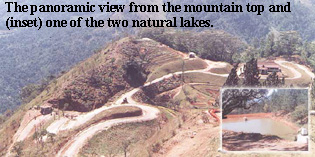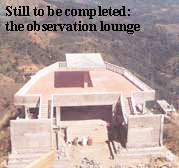
21st January 2001
News/Comment|
Editorial/Opinion| Business|
Sports| Mirror Magazine

Sri Lanka's first bio-diversity park to be opened soon at Ambuluwawe
Mountain attraction
By Chamintha Thilakarathna
The half-hour drive from Gampola town via Hemmathagama road up the Ambulu-wawe mountain does not offer a particularly breathtaking view. But once on top the feeling is heavenly.1072 metres above sea level, the view is beyond description. Amongst
the clouds, mountain tops rise on all directions. Bathalegala, Knuckles,
Deraniyagala, Adam's Peak, Pidurutalagala, Hunnasgiriya, Bible Rock, Allagalla
and Rassagala, can all be seen so clearly that one might be forgiven for
feeling they are close at hand. Below, the view encompasses the Mahaweli
and the city of Kandy, Gampola and  Peradeniya.
Peradeniya.
The view apart, the 450-acre Bio-Diversity Park of Ambuluwawe is the mountain's chief attraction. A large gate at the entrance leads to a series of roads that twist and turn around the mountain like an endless, coiled snake. On the mountain slopes, various spices, fruit and ornamental plants can be found
A Cabinet approved project, initiated by Minister D.M.Jaya-ratne under the supervision of the Department of Agriculture, the Park provides visitors with an overall experience of nature.
On the peak, there are three main attractions; an observation lounge, a bo-tree, and a chaitya. One might wonder what their fascination is. Be ready for the unexpected as the bo-tree is a sapling of the Sri Maha Bodhiya in Anura-dhapura, while the chaitya is a monument to all farmers and agriculturists. Its structure is such that the lower part is in the shape of a 'vee bissa', the upper part is pumpkin-shaped and the top built in the shape of a coconut. Standing one hundred and fifty feet high above the peak, it offers a magnificent view. The chaitya was built with contributions from villagers totalling over a Rs.105 lakhs.
Site supervisor P.U Wijesinghe said construction was difficult as it
meant transporting building material to the top of the mountain. "Five
floors had to be built, inclusive of a large balcony. This is Sri Lanka's  first
monument to farmers and it is truly magnificent," he added.
first
monument to farmers and it is truly magnificent," he added.
The large open-air observation lounge is the first Sri Lankan observation platform built on a mountain. A powerful telescope is to be installed so that a closer look at the mountains and surrounding areas is possible. On a clear day, visitors say they could see the sea from the Ambuluwawe mountain top.
A member of the design team, surveyor and architect, G.W Chandraratne said that the project started in 1994 now attracts many local and foreign tourists although it is yet to be completed. "It will take a few more months for us to complete the park and add the final touches. But every plant, every stone, and even the roads, have been specifically designed to conform to the idea of creating Sri Lanka's first bio-diversity park which is not simply a holiday destination but also an educational centre.
"The concept behind the bio-diversity park is the traditional one of a tank, chaitya, and the village. There are five villages that develop under this project and there are two natural tanks," he said. "There are wild animals roaming freely on the mountain and if you are lucky, you might catch a glimpse of them. Natural streams and springs provide water to the tanks. Nature is undisturbed."
The beautification of the park is handled by the Peradeniya Botanical Garden officials. The park has been divided into several sections, herbal plants in one area, ornamental plants and many types of fruit and spice collections in others. Plant species from all over the country have been planted here. Several endangered plants have also been preserved under this project, along with many rare herbal plants.
"There is a palm collection, national foliage collection and medicinal plant collection. A reflexology path, reptile collection, an amphitheatre where educational dramas can be staged and guided nature trails are some of the attractions plan-ned," said Dr.S. Wijesundara, Director of the Peradeniya Botanical Gardens and a Director of the bio-diversity park.
The official opening of the park is likely to be in mid-2001. "This is the first time a bio-diversity park has been built and we have many more plans lined up," Dr.Wijesundara said on a hopeful note.
Park officials, however, make a plea to the public not to uproot the plants or to destroy the atmosphere by littering or disturbing the peace of the park. "Already some plants have been stolen by the public. Even the large copper information board giving details of the view and of the surroundings has been stolen," they said.
Most plants are also on sale. But as the officials point out this park also consists of forests. Why forests in the plural? Because it includes ten acres of natural forest with over 4,000 plants at the location, a forest of pine trees, a forest of herbal and medicinal trees where people could take a guided walk.
Two circuit bungalows at the site provide accommodation for those who want to stay over.
The smaller bungalow can house twelve persons. An international conference hall on location that can accommodate 250-300 persons is often booked.
Another attraction at the park is a 200-metre tunnel where wall paintings and agricultural information are inscribed. This tunnel leads to the top of the chaitya. The peace tunnel as it called is significant as it is built on the park's border and thus connects the Central province and the Sabaragamuwa province.







![]()
Front Page| News/Comment| Editorial/Opinion| Plus| Business| Sports| Mirror Magazine
Please send your comments and suggestions on this web site to

